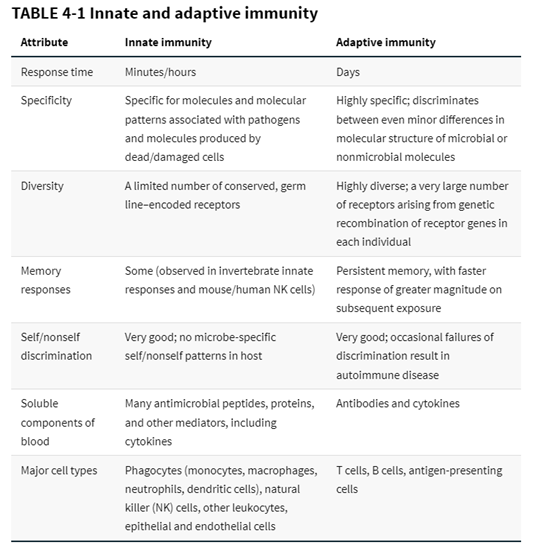Innate Immune Barrier Overview
1/20
There's no tags or description
Looks like no tags are added yet.
Name | Mastery | Learn | Test | Matching | Spaced |
|---|
No study sessions yet.
21 Terms
know table

know table
| Innate | Adaptive |
Cells | Myeloid-lineage | Lymphocytes |
Molecules (receptors/ligands) | PRR’s PAMPs/MAMPs | CD4, CD8, etc. MHC |
Time | Fast initial response (min) | Delayed initial, fast secondary (days) |
Clonality | Polyclonal receptors | Monoclonal receptors |
Diversity | Limited number of patterns | Greater diversity potential |
Memory | Limited memory (inheritance) | Extensive memory system |
Soluble components | Cytokines | Also use cytokines |
Self/Non-self distinction | Very good | Also very good |
3 types of barriers
physical, cellular, chemical
Skin innate immunity
proteases, DNAses, RNAses (more RNAses)
Mouth innate immunity
Enzymes, antimicrobial peptides, flow of fluid toward stomach
Stomach innate immunity
low pH, digestive enzymes, bile salts, antimicrobial peptides, fluid flow to intestine
Small intestine innate
digestive enzymes, antimicrobial peptides, flow to large intestine
Large intestine innate immunity
Intestinal flora compete with invading microbes, fluid/feces expelled from rectum
Airway and lungs innate immunity
Cilia sweep mucus, coughing, sneezing expel mucus, macrophages in alveoli
Urogenital tract innate immunity
flushed by urine and mucous, low pH, antimicrobial peptides and proteins
Salivary, lacrimal, mammary gland innate immunity
Flushed by secretions and mucus, antimicrobial peptides and proteins
lysozyme
found in tears, saliva, respiratory fluids and cleaves the peptidoglycan component of bacterial cell walls
lactoferrin
bind iron ions so microbes can’t use them for metabolism
Calprotectin
binds calcium and divalent cations so microbes can’t have them for metabolism
Psoriasin
produced by skin, has antibacterial activity against Ecoli
Anti-microbial peptides
smaller than antimicrobial proteins, can infiltrate bacteria cell membranes, include defensins, cathelicidin,, histatins, and dermicidin
Defensins
skin/mucosal epithelia, fight bacteria, fungi, protozoan, and viruses, can have intracellular toxicity
Cathelcidin
mucosal epithelia, fight bacteria, can have intracellular toxicity
Hisatins
saliva, lectins fight fungal infection
Dermicidin
skin (sweat), antibacterial/fungal
Surfactants and Collectants
both immobilize/trap bacteria to be killed